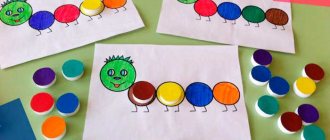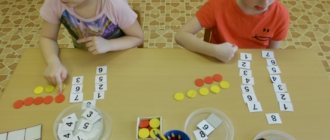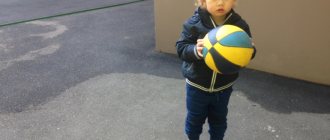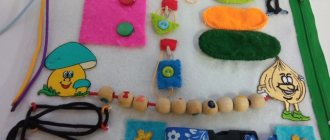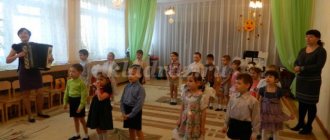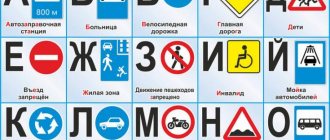The use of this part of the subject-development environment is aimed at:
- development of discipline and the ability to complete what is started;
- improving attention, thought processes, imagination and speech skills;
- recording acquired knowledge and skills;
- developing the ability to work in a team, friendliness and cooperation.
The use of games allows us to identify children’s areas of interest, determining their preferences during play. A variety of material teaches preschoolers to generalize objects according to a certain characteristic, to distinguish them from each other depending on their use and purpose. Also, during the game, the child notices the relationships between objects and learns to form a whole from the resulting parts.
An important point in the game is the need to choose a partner for interaction and find your place in the group. Children are divided into pairs or triplets, and a large number of students in the group significantly complicates the task.
The teacher plays the role of a guide in the game; he pushes the children to take the right actions, rather than directing the process. Also, do not forget about praising and encouraging the success of preschoolers.
The card index of printed board games for children aged 5-6 years old, used in kindergarten, includes the following materials:
- domino;
- checkers;
- puzzles with different numbers of pieces;
- pictures made up of cubes, the pattern on the edges of which relates to a specific image;
- mosaics;
- didactic games in pictures.
The use of games affects visual perception, which is an important element of the educational process in preschool educational institutions. To include printed pedagogical material in children’s activities, it is necessary to remember that the principle of visualization implies the presence of a visual example. That is, in order to assemble the puzzle, the child will need the original whole picture as an example.
Visual perception is developed by games such as mosaics, cards with images of animals and plants, and plot pictures. For the same purpose, teaching materials are included in the work in the form of a field map with a set of chips and cubes.
Visual material
Visualization is one of the main principles of gaming activities and the entire educational process in kindergarten. To carry out this work, certain visual aids are required. In other words, to create a picture from a mosaic, you need its diagram, and to create a picture from a puzzle, you need a solid image as a hint.
Games based on visual perception of information are associated with games such as:
- plot or symbolic pictures, images for the development of speech, mastering the basics of mathematics, familiarization with the world of things and nature, etc.;
- puzzles (including three-dimensional ones);
- lotto and domino sets;
- cubes;
- mosaics;
- “Adventure games” with chips and dice.
In order not to lead to hysterics, immediately stipulate that each child will have his own set of props, for example, a separate puzzle. If kids see such toys for the first time, then you need to give them time to get to know each other, and only then move on to playing. Please note that in younger groups, the folding process itself is important for children, so the picture should be the same - then there will be no tears. In older groups, you can give each student their own puzzle, and the pictures will be different. If time allows, then include in the game the stage of exchanging details: this way the kids will be able to put together different stories, and training motor skills and thinking will be more productive.
Another important point. For some games, for example, lotto, dominoes, it is assumed that there is one set for a certain number of players. But there may be more children in the group. In this case, you should take care of purchasing not one, but two sets. And divide the playing chips (or other game materials) equally.
Timing game plan
All elements of the educational process in kindergarten must be strictly timed. Only in this case there will be no violations of discipline, and all new information will be perceived as efficiently as possible. The game plan consists of 3 important stages:
- Introduction – 1–2 minutes. The teacher explains or reminds the rules of the game and distributes the necessary materials. If they are already prepared on the tables, then the purpose of each is explained.
- The game itself takes 3–7 minutes. The teacher helps and guides the children’s actions if necessary.
- Summing up – 1–2 minutes. At this stage, it is important to praise each participant, regardless of the success of the results of his game.
Even the lotto game is played under the supervision of an adult
An example of the timing of the game “Where can I buy this?”
When studying the topic “Shopping,” the teacher explains to the kids in which departments of the store this or that product is sold. The purpose of this game is to consolidate children’s knowledge about various products and departments of stores (grocery, hardware, etc.), develop the ability to navigate the environment, and cultivate a desire to help adults.
- Explanation of the rules: children discuss where mothers buy certain products, then the adult hands out small pictures of the products, and hangs a large poster on the wall depicting various departments of the store (2 minutes).
- Children arrange the pictures into the appropriate sections, explaining their choice (2 minutes).
- Summing up (3 minutes).
Game “Where can I buy this?” develops the preschooler’s ability to navigate the world around him

